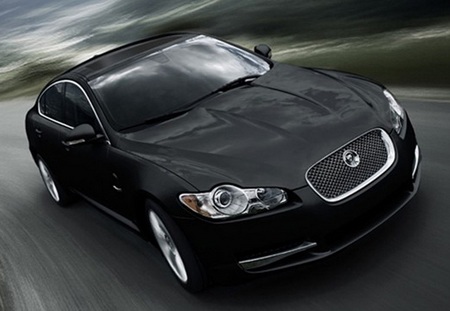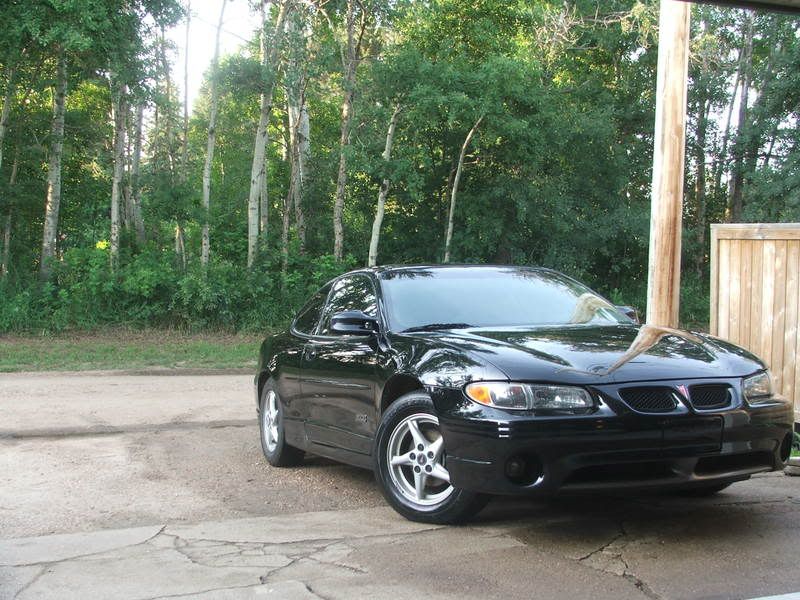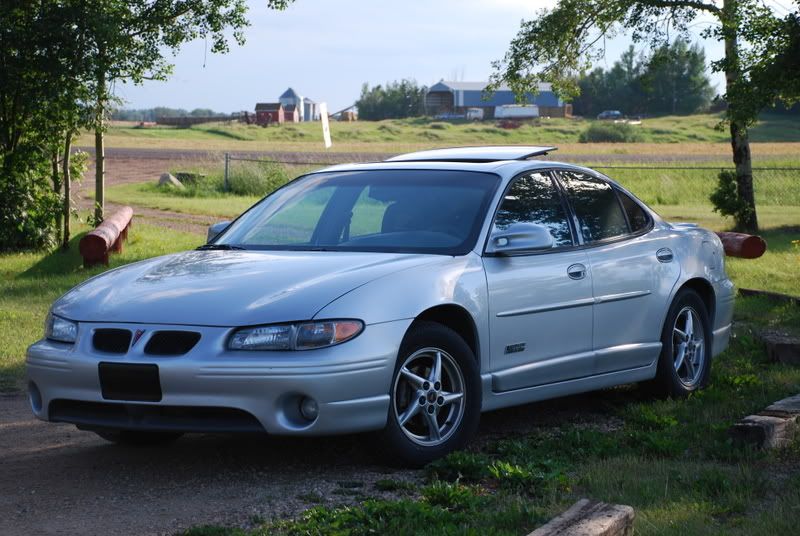Fuel Injected, Supercharged, Grand Touring Sedan, sounds great doesn’t it? Makes you envision a heavily optioned “saloon” car with a surplus of horsepower and sporting pretensions, given that and nothing else, I would imagine a typical Jaguar four-door.
 |
| Photo Credit: www.itechnews.net |
In this case we are talking a much lesser vehicle that befits that description, a Pontiac in fact, and in my case two of them.
In 2006, it came time to replace the better half’s daily driver; her aging 2000 Ford Focus was displaying all manner of expensive temperament, and needed to go. As a car enthusiast new car shopping is always an exciting time, and I quite enjoy the entire process.
A Mustang guy myself, it’s sometimes difficult not to use these opportunities to add another pony car to the stable, and actually step back and listen to what she wants in a car. So far it’s been four cars and I haven’t brought her home with a new Mustang she may or may not have actually wanted, so I think I’m doing pretty well.
The hunt for a new car was actually kicked into gear with her taking a new sales management position and having the responsibility to occasionally ferry clients to various properties around the city. Thusly she wanted something a little bigger than the compact Focus but from a personal side was well optioned. My only input was to have a little bit of driving pizzazz; we both agreed minivans were right out.
Saving the details of eventually coming up with two contenders, it was down to two domestic mid-sizes; the Ford Taurus and the Pontiac Grand Prix. Since we were in the used market there were lots of options on the sales lots, and since each had a “sport-touring” model, driving interest could be retained. I was hoping to see a V8 powered Ford Taurus SHO but did appreciate the specs of the Pontiac Grand Prix GTP edition. Both cars are heavily optioned with “wife ordained” mandatory creature comforts like a moon-roof, and leather interior, but the V8 SHOs did have their known problems.
For anyone who isn’t on the up-and-up, here’s the skinny on the third generation SHO:
 |
| Photo Credit: www.howstuffworks.com |
For 1996, the SHO was redesigned. Unlike its predecessors, this SHO was more refined and used less radical bodywork. It differed from the normal Taurus with different seats, wheels, bumpers, drivetrain, as well as a fin being put on the driver's side windshield wiper, to keep it on the windshield at high speeds. A 235 hp (175 kW) aluminum 3.4L V8 engine with heads from Yamaha and block from Cosworth was specified for the SHO model, but it was given the same four speed transmission as the LX: the manual gearbox option was no longer offered on the SHO. Separation of the camshaft from its sprocket has been implicated in a growing number of engine failures, at around the 50,000 mile (80,000 km) mark. The standard warranty on this model was 36,000 miles (58,000 km). This problem can be rectified by having the camshafts welded. This SHO sold model from 1996-1999.
When the decision time came around, the SHO was discounted only by the fact the wife regarded them as “grandpa-cars” on the grounds her grandparents bought a new Taurus LX every few years. So by a sense of default the Pontiac won the day.
At the time I wasn’t too put out as the Pontiac had plenty of good points and I was eager to see what Brand-X had to offer. The GTP was built on the FWD W-body platform which replaced a rear drive G-body (think Monte Carlo) back in 1988. So by 2006 the W-body was everywhere, and reasonably had all the engineering bugs sorted out.
The power plant, as front drives go, looked good;
Quote:
The L67 is the supercharged version of the Series II L36 and appeared in 1996, one year after the normally-aspirated version. It uses the Eaton Generation III M90 supercharger with a 3.8" pulley, a different throttle body, fuel injectors, cylinder heads, and lower intake manifold than the L36 uses. Both engines share the same engine blocks, but compression is reduced from 9.4:1 in the L36 to 8.5:1 for the L67. Power is up to 240 hp (180 kW) and 280 lb•ft (380 N•m) of torque. Final drive ratios are reduced in most applications, for better fuel economy and more use of the engine's torque in the low range. The engine was built in Flint, Michigan. The engine was certified LEV in 2001.
The 3800 Series II was on the Ward's 10 Best Engines list for 1995 through 1997
A force-fed GM 3.8L might sound familiar to some of the more astute readers, especially given the reference to the RWD G-Body above. Focusing for a moment on the predecessor of the W-body, take a look at the revered Buick Grand-National, the car is something of a performance legend and it was equipped with a Turbocharged 3.8L V6. It is not difficult to think of the GTP series then as the next evolution of that concept. Albeit watered down with a less efficient supercharger and front-wheel drive, but one would believe to be a good working platform.
The Black Car:
So the choice was made, and we ended up purchasing a Black 2002 GTP from the final production year of two-door configuration. Sold from an Edmonton dealership as a GM Optimum used vehicle with around 70,000kms, we purchased a 1 year warranty as a just in case.
Initially we were quite happy with the first non-Ford purchase; it got great fuel economy on the highway, (well into the 35 MPG range) had cool options like dual-zone climate control, a HUD, (Heads-Up-Display) and the supercharger offered great boost to pass capability. Surprisingly you could fit a 6’5” adult in the back seats with comfort, and the wife adored the heated driver seat in the winter… Overall it was great; the brakes sucked but were improved with some Hawk HPS pads, and the transmission was lazy but it worked fine.
A missed feature was a performance shift button found in all pre-2001 GTPs, I understand it would really liven up the driving experience, but GM had far too many warranty claims with destroyed transmissions so it was disabled for all future models. As a result the car would flat out refuse to drop down to 2nd gear on a WOT downshift, and don’t think moving the shifter will help, the vehicle PCM maintains full control during WOT conditions. Even on the upshifts you can leave the gear selector in 1st flatten it and it will continue to change up through the gears 1-2-3, only Overdrive will stay locked out. So there is no gain in manual shifting it, it does what wants anyway.
You can probably tell there is a foreboding overtone to the whole article. So where did it all go wrong? About 3,000kms after the warranty was up of course.
I think the trouble first started with a small thing like a chip in the windshield, which to have replaced required a HUD compatible unit that cost a fair bit more than the “regular” type. This was never repaired as there were other things that came more pressing.
During the second winter of ownership the heater blower fan failed. Removal is bothersome with Torx fasteners under the dash. Inspection revealed the motor to be full of water and rust, turns out these cars have a tendency to drain the cowl and A/C condensation into the heater fan. $130 and an afternoon of work behind the dash later, it was fixed.
A few months after that, around 105,000km the car destroyed a rear wheel bearing. Of course these are non-rebuildable assemblies that come packaged as a spindle, hub, bearing, and ABS sensor unit. My cost was in excess of $230 cutting a wicked deal, list price is a fair bit more.
Not more than a month later the driver side power window switch said no more, and luckily failed in the up position. As the two door cars are somewhat less common than the four door units, there were no junkyard parts available, so this dealer only item cost us about $300, as another assembly of course.
At that point I was mildly irritated with this ongoing “nickel and dime” expenses but I figured we were done, and I couldn’t be more right.
That spring… cancer.
It first started as a small flake under the rear driver’s wheel arch, in no time at all it was the size of the palm of your hand. Not just the clearcoat, or the paint, but right down to bare metal. Professional estimates were obtained and the prognosis; too severe to blend, full respray, left untreated it was predicted entire panel would follow. But serious consideration was recommended; as more rust was discovered under the sills, strut towers, trunklid, (which was full of water from a faulty spoiler seal) and the doors.
To drive another nail in the casket, the power moonroof was having fits despite being periodically lubricated and cleaning the tracks. Something in the gear drive started shuddering and skipping, it became another one of those “do not use” features.
There were a few other minor things, but by this time the decision was made to trade the car that summer, before this Quebec lease return cost any us more money. Upon trading, the car clocked in at less than 115,000kms, had developed a leaking transaxle seal, and dreadfully needed a set of struts even though the dealer had replaced them just prior to purchase.
The Silver Car:
The silver car you ask, that implies they got another one, and we did. As this is the wife’s car, and she really found nothing wrong with the GTP from a function point of view, she wanted to try another. To be honest, I kind of wanted to give the platform another chance, it was easy to put off much of the Black car’s problems to being from previous abuse and exposure to Eastern Canadian winters.
So in the summer the black car went away, and a shiny and slightly newer 2003 four door GTP took its place. Immediately I was quite impressed with the ride quality and reduced steering effort, I suspect there were more problems with the black car than I had already discovered.
Got a lemon, traded up, and happily ever after right?
Not so much.
This car had been equipped with a few different options from the black car, but most notably was the lack of a HUD and addition of a factory BOSE stereo system. While I’m not an audiophile, I did appreciate the new arrangement, but sadly someone spec’d out a base single CD head unit without equalizer.
That particular head unit is the cause for my initial concern, within the first three months of ownership; the display quit working. So now the clock function is gone, and tuning radio stations is a matter of listening to each for awhile, not a deal breaker but what was I in for now?
As that winter came and progressed, so did the problems, firstly the car has an overly optimistic fuel gauge. 500kms travelled and still at ¾ of a tank, since I know this car isn’t equipped with the Roadwarrior’s 200 litre fuel bunkers, we had problem number two. Currently the process is to set the trip meter on each fill and seek gasoline upon travelling 400km’s (gives 100km buffer) so far it hasn’t left us stranded, but her CAA membership is kept up just in case.
Problem number 3, this one is a bigger one.
One winter morning in January, I received a call from the wife while I was at work, she told me the engine overheat light had tripped and she had parked the car immediately. I asked if anything else was observed and she complained the car wasn’t making heat.
Looking at the outdoor temps of -18*C coupled with the lack of heat, I knew I had troubles, likely expensive ones. I went down to take a look and found the radiator was empty with no obvious leaks, I topped up, burped the system and adopted the wait and see attitude. This action returned full heat, and got her going for the next week, and once the problem recurred I had already made a decision, send it to the dealer. This could be intake gaskets or head gaskets, one not so bad, the other would be a fair bit of downtime for me to tackle at home. Pulling the exhaust manifold from the rear cylinder head on these cars isn’t fun without lift we couldn’t really have her daily driver out of commission for too long.
The dealer was able to diagnose the problem in less than 20 minutes and the repair was completed before lunch. The issue? Blown intake gaskets, and a cracked thermostat housing, $1200 parts and labour, the service manager sympathetically offered, “We get this problem a lot.” That’s why the parts are kept in stock I understand.
Fun fact; It turns out that GM’s proprietary DEX-COOL could be called gasket kryptonite, as it dissolves them quite quickly.
We were trouble free until spring, when a front wheel bearing gave up at 95,000kms, see above for the cost. Last month the windshield washer died, it was cheaply fixed from a local self service junkyard, where the lot is dominated by GM front drive cars. Teardown of the washer pump revealed it chock full of rust, clearly the O-ring had failed allowing the pump to flood.
Recently, I’ve spotted a few little leaks and squeaks that don’t bode well for the future of this car, and given the track record of these two vehicles, we are now beginning the search for a suitable replacement. This time however I’m not sure where this search will take us but surely any GM product will be met with extreme apprehension. Speaking with other past Grand Prix owners we are so far doing pretty well, for example our transmission hasn’t failed twice in five years.
Here’s a bonus section, you still want to try your luck and really make the most of this performance vehicle?
Modifying a Pontiac GTP
Short answer, there are 9 seconds GTPs out there, but for the money and time, nearly anything will run 9 seconds. Road racing with an under-steer prone, automatic, FWD, 3500 pounder with marginal braking capacity, isn’t my idea of the best way to go about business.
Long answer, there are only a few companies that specialize in the W-body platform, perhaps the most successful is ZZ Performance. They offer a wide range of performance parts to really enhance these vehicles and fairly good prices, sales plug aside they also have an informative technical section.
Things you may wish to know:
1. Increasing Boost – Easy as a pulley swap, 6 psi stock leaves lots of room to grow, until you consider there is no factory intercooling present. Be prepared to plan for that purchase.
2. Tuning – Currently there are no handheld user tools, you must physically swap PCMs to a burned module from one of the very few tuners. They are VIN specific so that can cause problems at the dealer if you aren’t careful.
3. Transmission – Hit and miss at stock power levels and guaranteed DOA at 300 BHP
4. The exhaust is crap and expensive to upgrade, consider the U Bend delete
5. Final Drive is in the 2.93 range from factory, performance option is in the 3.30 range, not a stellar offering really.
6. Differential – Factory open, very expensive and limited LSD options, plan the upgrade for when the transaxle fails.
7. Brakes – Either hawk pads or F-body brakes, that’s about it.
8. Wheels & Tires – The factory 225’s only allow ½” of clearance between the sidewall and the strut coilover spring cup, pick non-standard sizes with caution.
I’ll conclude that this otherwise sound platform was short-changed by the ineffectiveness of its supporting components, hence the title; “Looks good on Paper.” We are currently planning to replace this vehicle during summer of 2010 with something...different.
Thanks for reading
Darren (5.0L) Lynch
Read the Entire Living with a Pontiac Series:
Looks Good on Paper:
UPDATE 1 –
UPDATE 2 –
Back in the Grind - Looks Good on Paper & Living with a Pontiac


